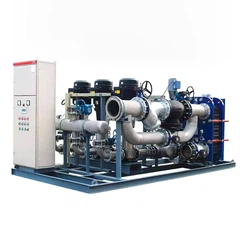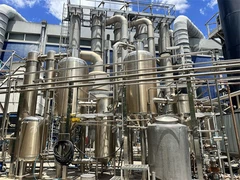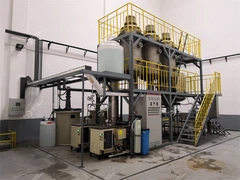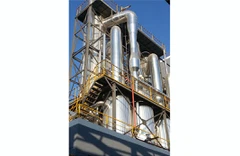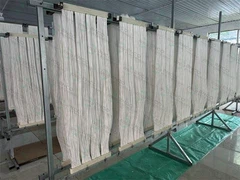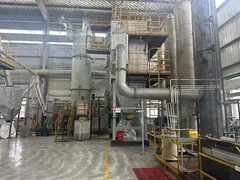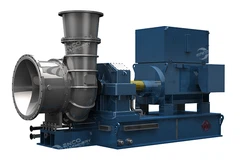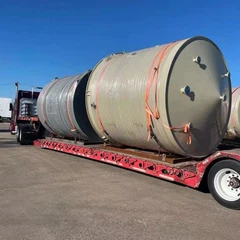Details of evaporation system for fermentation industry

Introduction to the evaporation system in the fermentation industry
With the development of the fermentation industry, evaporators have been used more and more widely in the fermentation industry. Taking corn deep processing and its conversion as an example, corn deep processing and conversion consists of many industries, and many industries use evaporators for evaporation and concentration operations. Moreover, evaporation and concentration are key production process links.
However, the evaporator is not a general evaporation and concentration equipment. The design, material selection, manufacturing and use of high-efficiency and energy-saving evaporators should be adapted to the properties of the concentrated materials and process requirements. Only in this way can the evaporator's effective performance and energy-saving and consumption-reducing effects be fully utilized, and play an increasingly important role in the development of the fermentation industry and the comprehensive utilization of products.
The fermentation industry in my country is developing rapidly, especially in the field of corn as raw material. The progress is even faster. Corn starch sugar, glucose, maltodextrin, xylose, xylitol, oligosaccharides, vitamin C. Citric acid and other industries have emerged, and corn comprehensive utilization, such as corn infusion, DDGS, and protein feed, also have a certain scale of production. In these industries, evaporators have played an irreplaceable role.
Common processes of evaporation system in fermentation industry
Evaporation or evaporation crystallization device is required for the processes of fermentation liquid concentration, fermentation product extraction, and fermentation wastewater treatment of fermentation industry products. At present, common fermentation evaporators are of different types due to the different evaporation processes they adopt, such as: single-effect evaporation process, multi-effect evaporation process, single-effect TVR evaporation, multi-effect TVR evaporation, and evaporation-evaporation crystallization combined process.
Falling film evaporator is a kind of film evaporator, which is recognized as one of the more advanced types of evaporators. In recent years, it has replaced other forms of evaporators in many industries and become the main evaporation equipment in the fermentation industry. This is because falling film evaporator has many unique advantages:
1. It can reasonably use heat pumps and adopt multi-effect evaporation and other forms to generate steam and cooling water consumption;
2. The production capacity develops towards large-scale, continuous and automated, with simple structure, convenient cleaning, operation and maintenance;
3. It is suitable for a wide range of materials and adopts different forms according to the requirements of various pH values and materials. It is suitable for materials with relatively high viscosity and concentration (viscosity ≤450cp);
4. Evaporation is carried out under vacuum conditions and the evaporation temperature is low. High yield, short heating time of materials, can retain the original color and smell of the processed materials to the greatest extent.
Features of evaporators suitable for different industries in the fermentation industry
1. Glucose, starch sugar, maltose syrup, oligosaccharides, maltodextrin and other industries
Sugar solutions are generally heat-sensitive materials, and their product quality depends to a large extent on the evaporation temperature and heating time.
The production scale of the above-mentioned industries in the fermentation industry is relatively large, and energy saving and consumption reduction are the goals pursued, so it is more appropriate to use three-effect or four-effect falling film evaporators. When the number of effects continues to increase, the equipment cost increases significantly, while the operating cost reduction is not obvious, and the material flows through the equipment for a long time.
The viscosity of these processed materials is relatively large. Taking glucose aqueous solution as an example, at a concentration of 30% and a temperature of 50'C, its viscosity is 2cp. At a concentration of 75~78% and a temperature of 60C, its viscosity is 100cp. The increase in the boiling point of the solution cannot be ignored during design. The heat exchange area of the evaporators used in the above-mentioned industries is relatively large, and the evaporation intensity is relatively low. Under the same evaporation capacity, the heating area should be increased by 30% compared with the evaporation medium used for concentrated milk and water. The holes of the sieve plate of the film cloth should also be enlarged.
2. Concentrated evaporator for corn soaking water
When using corn as raw material to produce starch by wet grinding, dilute sulfite water is used to soak corn. After soaking, the corn can be well separated from the starch, protein, germ and fiber in the corn. The soaking water after soaking corn is also called corn pulp, which contains soluble protein, lactic acid, amino acids, sugars, phytates, various water-soluble vitamins, inorganic substances, etc., and has a wide range of uses.
Phytin-based inositol phosphate can be extracted from corn pulp, which can be used as a culture medium for fermentation industry after concentration, and can also be used as an additive for gluten feed. Therefore, the evaporation and concentration of corn pulp is an important part of the starch production process.
3. Low-temperature falling film evaporator for the concentration of vitamin C solution
Vitamin C is a very important water-soluble vitamin substance that cannot be synthesized by the human body. People must take a certain amount of vitamin C from the outside to maintain normal human survival and reproduction. With the continuous improvement of human living standards, vitamin C is not only widely used in traditional medical and health care, but also widely used in food, candy, beverages, animal husbandry, daily chemical industry and other industrial sectors.
Vitamin C is synthesized by biochemical method with sorbitol and glucose as starting materials. The production technology of vitamin C has also developed rapidly. There is the traditional Leibniz method. my country is in the world's leading position in this regard. Taking sorbitol as the starting material, a two-step fermentation method is used to produce the precursor of vitamins, 2-keto-L-gulongsuan aqueous solution, and then the falling film evaporator is concentrated from 4% to 40%, and then crystallized, separated and dried, and then lactonized to become vitamin C (L-ascorbic acid). Glucose can also be used for direct fermentation to produce vitamin C.
4. Application of falling film evaporator in xylose and xylitol production
Xylose and xylitol have low sweetness and low calorific value. They can replace sucrose in the food industry, and can also reduce blood sugar in diabetics and prevent children's tooth decay. It is widely used in printing and dyeing, oil extraction, rubber, construction, pesticides, medicine, leather making and other industries.
Xylose and xylitol are made from corn cobs, sugarcane residues, sawdust and straw after crushing, fermentation, hydrolysis, decolorization, filtration, concentration, crystallization and drying.
The multi-effect evaporation system and MVR evaporation system developed and manufactured by our company have significant energy-saving effects and a very high degree of automation, and are very suitable for product evaporation and concentration in the fermentation industry.
Process flow of evaporator application in the fermentation industry




